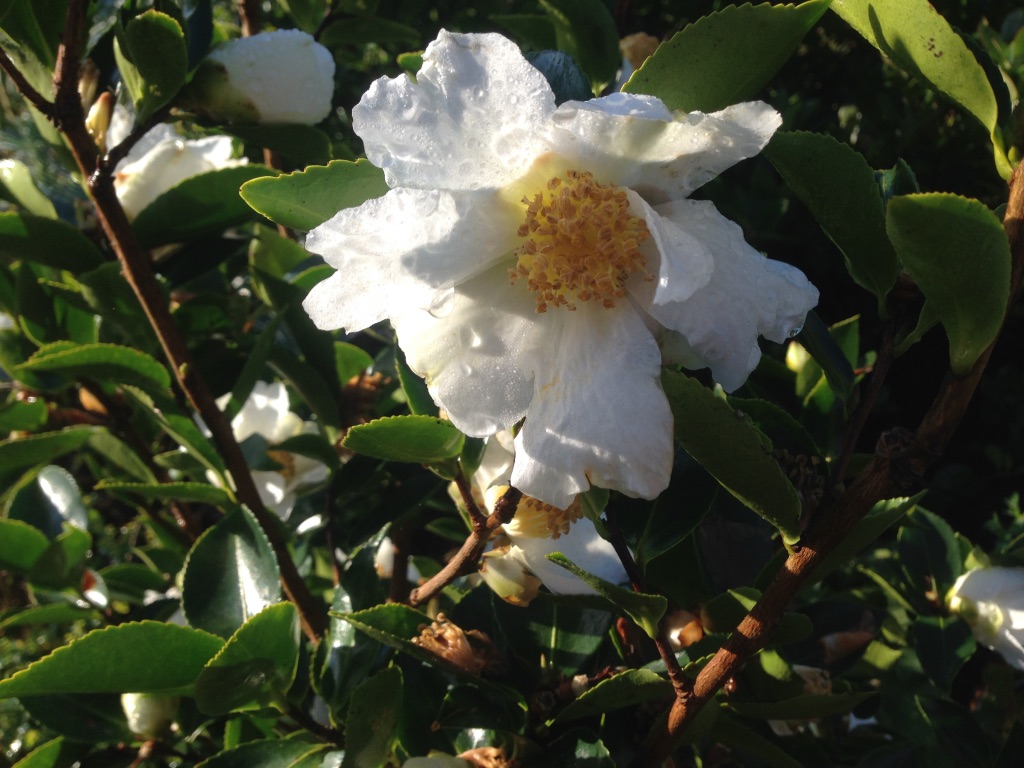Our resident gardening expert Alison Agnew has some useful tips on how to cope with the winter deluge. But first – its all about keeping our gardens colourful.
November is the time to brag about the length of our growing and flowering season in Cornwall – (if you don’t still have colour in your garden you should be ashamed!)
The autumn flowering Camellias are already out this year in October but should keep going through November and December. I love the single flowered varieties of Camellia sasanqua and the insects like them too.



I’ve only just understood how lovely and how useful Chrysanthemums are at this end of the year. For me, Chrysanthemums were always garage forecourt and funeral flowers but Sarah Raven has done much to popularise them and has some lovely varieties. I’ve bought most of mine from the wonderfully named Halls of Heddon and Wooten’s of Wenhaston – both great old-fashioned nurseries. They sell a lot of (gopping?) show bench varieties but also have nice selections of hardy Korean Chrysanthemums – much more delicate and the latest to flower. Talent spot them now and place your order for spring cuttings – they will flower in their first autumn. Winter wet is their enemy – put them somewhere well drained.
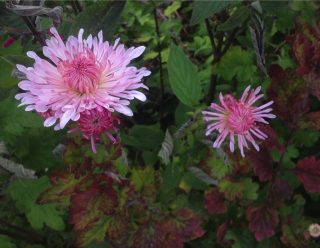

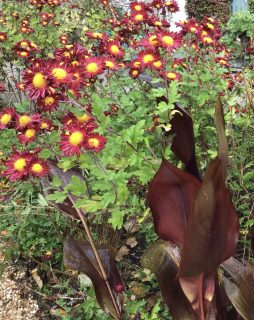
If you pulled your dead Alstroemeria flowers out in July, they should be up and flowering again now and will keep going for at least another month if you continue to pull out the spent flowers.
Many Salvias will keep going too — Salvia Amistad and its bluer sister Carrine’s Amazing flower all through November and I’ve picked a bunch for Christmas before now.

Climate change – coping with a deluge
So many plant labels specify those magic conditions ‘moist but well drained’ – in the past a relatively easy condition to achieve, at least in Cornwall, but what about the future? SW Water had a 13 month hosepipe ban over last year so why are we concerned about too much water? Too little and too much are both problematic and both are likely to become greater issues for gardeners as climate change is predicted to cause more frequent extreme weather events.
Our soils on the Roseland are derived largely from ’head’ deposits – produced under tundra conditions during the last ice age, they consist of unstratified mixes of shattered slate material and clays. You can see these deposits exposed along the cliffs – especially around Gerrans Bay.
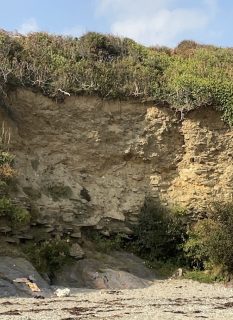
Clay-rich soils can hold a lot of water and require the addition of good amounts of organic and/or gritty material to prevent compaction and water logging. Water-logged soils exclude the oxygen needed for respiration by plant roots and will kill all but especially adapted bog and pond species.
How can we adapt our gardens to cope with extreme rainfall events?
- Create better drainage, avoid too much solid paving and use gravel surfaces for seating areas, paths and parking. Even with packed hardcore underneath, gravelled areas will reduce rapid runoff.
- Improve water movement through the soil by incorporating more organic material and/or grit. This helps to keep plants happy in the topsoil but won’t rapidly take a lot of water away in an extreme rainfall event.
- Use drainage trenches and land drains within the garden to avoid releasing the excess water into the communal land drains but to redistribute the water within the garden rapidly. Dig trenches and fill with stone rubble and/or run perforated land drain along them. They should be 250mm wide and ideally 900mm deep so a mini digger is a good shout unless you have a lot of muscle available. Unfortunately 900mm was unachievable on our land where we often hit the solid rock only 300mm down or even less! In this case, it’s a good idea to run these drains under paths and lawns if possible, to avoid the possibility of damaging them while digging. Direct the water to where you want it – under trees or into a pond or a designated wetland area.
- Consider the flow of water through your property when planning drainage. When we were laying out the garden at Crugsillick, we thought we had put in enough drains but failed to consider the water landing on the 8-acre field above us or how it moved through our land to the river below us. Parts of our yew hedging have failed due to excess water movement into the trenches that we planted them into intending to give them a ‘good start’!
In the kitchen garden, even though we built raised beds and drains, we had to add more drains after we saw the poly tunnel turning in to a swimming pool for frogs. We redirected the water under the paths and a gate in the wall into the foot of our Monterey pines which now suck it all up – happily.
Create different ecosystems
Make a wet sump that your land drains feed into by digging a wide, shallow dip. Plant suitable wetland plants – like Siberian iris (Iris siberica), Japanese water iris (Iris ensata), water cannas (Canna glauca), Arum lilies (Zantedeschia aethiopica), candelabra primulas etc. If you make a pond make sure that you create boggy margins that can absorb overflows.
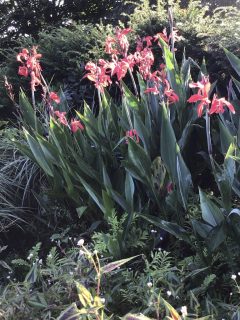


Make raised beds, banks and rockeries – use all that slate rubble that our Roseland gardens seem to breed to make a dry bank or rockery. Rockeries have gone out of fashion – no doubt condemned by those sad suburban rock piles covered in heathers. I’m a great fan – not of the heathers, but of the potential that sharp drainage gives for growing choice succulents, specialist bulbs, and other plants that can’t abide having soggy feet. I was shocked to lose plants in Cornwall that were perfectly hardy in our North Yorkshire garden – but there we had deep, well drained loam and half the rainfall. I still dream about that soil…
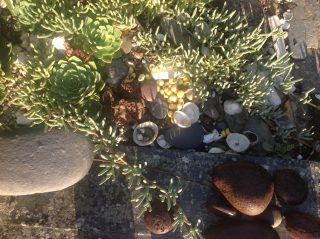
Create gravel beds. Have you ever noticed how many plants self-seed and thrive in gravel paths? I spend quite a lot of time digging them out and potting them on to plant back into borders that don’t favour them nearly as much. Beth Chatto developed a large gravel garden in the 1990’s that is much admired. The idea was to create a planting that would be self-sustaining on deep sandy soils and 20 inches of annual rainfall without irrigation. We don’t have her deep sandy soils and we have twice as much rain – we need gravel gardens to prevent plant trench foot! Echinaceas and Eryngiums need well drained roots and many small bulbs like the little species tulips, love a gravelly soil as much as succulents do.
Store at least some of it
We are often encouraged to add water butts to our down pipes and greenhouses. These can provide some useful clean water for your watering can but won’t cope with the volume of sudden rainfall events. To be useful, we are talking 6 -10 thousand litre storage tanks costing £2500 – £3500 to buy before the cost of installing, pumps and pipe work etc – so a serious investment.
Prevent soil and nutrient loss
Cover areas of open soil in vegetable gardens with a thick mulch of compost and/or plastic sheeting in winter to prevent heavy rains leaching out nutrients and washing away your precious topsoil. Humus and clay are good at hanging on to nutrients. You already have the clay but keep adding as much organic material as you can get hold of. If you add fertilisers to your soil, don’t use a lot of easily soluble ones like Growmore but use slow-release ones like blood fish and bone.

